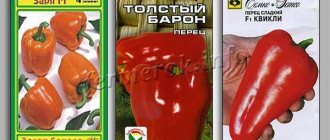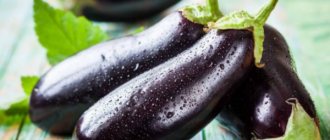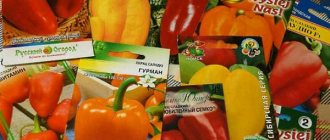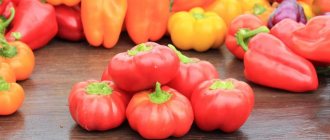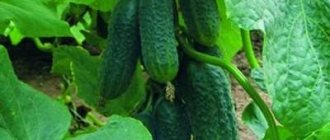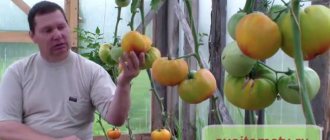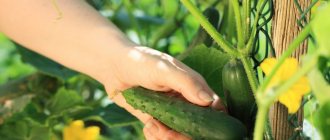Both sweet (Bulgarian, vegetable, salad) and hot (hot, chili) peppers are crops that are quite demanding to grow. They do not tolerate low ambient temperatures (up to 13°C and below), underwatering, watering with cold water, lack of light, cold drafts, and lack of garter.
Therefore, gardeners approach the selection of successful pepper varieties for cultivation in the middle zone (for example, in the Moscow region) both in greenhouses and in open ground. They are looking mainly for an unpretentious, productive variety, but the nuances already vary - for some, serve especially thick-walled peppers, for others, short stature and compactness of plants are important, for others, they expect especially early ripening, for others, they are looking for a pronounced sweet or spicy taste, and for others He even pays close attention to the size and color of the fruit.
Today we bring to your attention a selection of such diverse but well-proven varieties of sweet and hot peppers for the Moscow region, according to reviews from experienced gardeners.
Vegetable pepper Atlant F1
Mid-season, highly productive hybrid of sweet pepper (about 100-110 days from germination to harvest). Suitable for growing in greenhouses and open ground.
The plants are low (up to 80 cm), compact, and have few branches. Productivity – up to 5 kg per 1 sq.m.
The hybrid is “not afraid” of tobacco and potato mosaic viruses and quite successfully withstands adverse weather conditions.
The fruits are large and very large (up to 20 cm in length and up to 200-300 g in weight), strongly elongated cuboid in shape, thick-walled (wall thickness - 4-6 mm), bright red in color (during technical ripeness they are colored green ). The skin is glossy, the flesh is juicy, dense, crispy, with an excellent sweet taste and pronounced aroma.
The fruits have excellent keeping quality and transportability and are intended for universal use.
Be careful - various agricultural companies offer not only Atlant F1 hybrids, but also sweet pepper varieties with the same name. Depending on the selected manufacturer, the seeds they offer and the resulting plants may differ in some technical characteristics, such as ripening time or disease resistance.
Pepper diseases, pests and ways to combat them
Two problems that can arise when growing peppers outdoors are diseases and insect pests. A vegetable garden on a personal plot limits the gardener from taking timely preventive measures to prevent these misfortunes. Indeed, in greenhouse conditions it is much easier to plant seedlings in disinfected soil or protect plants from pests by treating the walls of the greenhouse. In open ground, an unprotected plant becomes a real bait for insects, and in moist soil there are ideal conditions for the proliferation of pathogenic microorganisms.
Verticillium
The causative agent of this disease is a fungus. It penetrates the plant through the roots. When pepper is infected, the leaf vessels are affected, making the plant unable to absorb moisture. There are several forms of this disease. With brown verticillium, the leaves become gray in color. With regular watering, the plant almost does not lag behind in growth, but looks wrinkled and drooping. Flowers and ovaries do not form on a diseased pepper bush, and the plant dies.
Dwarf verticillium
The disease manifests itself 30-40 days after planting the seedlings. The pepper seedling stops growing and drops its flowers and leaves. The main stem remains alive and forms new shoots, which soon fall off. The plant can live in this state for several months, but the infected pepper will no longer bear fruit.
Green verticillium
This disease can destroy a healthy plant in a few days. When affected by this form of the disease, a green pepper seedling with a large number of ovaries rapidly sheds its leaves and dries up.
Alternaria blight
This fungal disease is popularly called “dry spotting.” Pepper bushes planted in a bed where tomatoes grew last year are especially often infected. The disease is characterized by the appearance of dry brown areas on the leaves, trunks and fruits of the plant. After rain, these spots become covered with a black coating. The plant lags behind in growth, stops blooming and bearing fruit.
Septoria
The septoria fungus spreads in rainy weather. Gray-white spots with a rim appear on the plants. On the surface of these spots you can see frequent black dots - these are the spores of the fungus, which first infects the leaves and then moves to the trunk and fruits of the pepper.
Vegetable pepper Hercules
Mid-early productive variety of sweet pepper (about 90-100 days from germination to harvest). Suitable for growing in greenhouses and open ground.
The plants are small (up to 50 cm), compact, semi-spreading. Productivity is stable, up to 3.5-4 kg per 1 sq.m.
The variety is unpretentious in cultivation and is very resistant to a number of common diseases, in particular to fusarium and tobacco mosaic virus.
The fruits are large (up to 12 cm long and up to 200 g in weight), cube-shaped, very thick-walled (wall thickness - 7-10 mm), rich red in color (during technical ripeness they are colored green). The skin is glossy, the flesh is juicy, dense, crispy, with an excellent sweet taste and pronounced aroma.
The fruits have excellent keeping quality and transportability and are intended for universal use.
Pests
Pepper is one of the favorite foods of insects. Pests attack the leaves, stems and roots of plants, causing them to stop growing and die.
melon aphid
Despite the name, the insect feeds not only on melons and melons. This parasite can be seen on tomatoes, cucumbers, greens, root vegetables and other plants. Aphids do not disdain weeds either. Colonies of these insects are located on the underside of the leaf, gradually migrating to the stems and sepals. Leaves and flowers fall off, and the affected plant quickly dries out.
When aphids appear, the plants are treated with chemicals (fufanon, karbofos, etc.). If the attack of parasites occurred during the flowering or fruit setting stage of the pepper, then it is better to use folk remedies. Spraying peppers with decoctions of fragrant plants will repel insects from the garden for a long time. To prepare them, use potato or tomato tops, shag, garlic, and onion peels. Fumigation of plants with tobacco smoke is also effective. This treatment can be carried out after each rain - it will not cause harm to the plants, and will not affect the quality of the fruit in any way. It is also necessary to regularly get rid of weeds.
Spider mite
It is impossible to see this insect with the naked eye. Its appearance is eloquently indicated by the presence of a thin web on the underside of the leaf. The pest feeds on plant sap. The affected leaves turn yellow and fall off, and the mite moves to the stems and stalks. As a result of the spider mite attack, the pepper becomes deformed and soon dies.
To prevent the appearance of spider mites, it is necessary to clear the soil of previous plants before planting. This pest especially often settles on cucumbers, and if last year this crop grew in place of pepper, then it is advisable to treat the soil with fungicides or dig up the soil along with the ash. Spider mite larvae overwinter not only in the soil, so it is necessary to completely remove grass, fallen leaves and remains of cultivated plants from the area.
If pepper infection does occur, then you need to get rid of severely affected plants, thoroughly clean the ground of weeds and debris, and treat the remaining bushes with a solution of wood ash, infusions of onion and garlic.
Vegetable pepper Orange miracle
A mid-late, highly productive variety of sweet pepper (about 125-130 days from germination to harvest). Suitable for growing in greenhouses and open ground.
The plants are low (up to 80 cm), compact. Productivity – up to 8 kg per 1 sq.m.
The variety is very resistant to a number of common diseases, in particular to fusarium and tobacco mosaic virus.
The fruits are large and very large (up to 12 cm in length and up to 250 g in weight), cube-shaped, very thick-walled (wall thickness - 5-8 mm), bright orange in color (during technical ripeness they are colored green). The skin is glossy, the flesh is juicy, dense, crispy, with an excellent sweet taste and pronounced aroma.
The fruits have excellent keeping quality and transportability and are intended for universal use.
Be careful - various agricultural companies offer not only the Orange Miracle variety, but also F1 hybrids with the same name. Depending on the manufacturer chosen, the seeds they offer and the resulting plants may differ in some technical characteristics such as ripening time, yield or disease resistance.
How to care for peppers in greenhouse conditions
Planting care begins immediately after planting the sprouts.
Ventilation of greenhouses
Clean air must reach the plants. Greenhouses are opened several times a day for ventilation. After 5-10 minutes the room is closed.
Watering
Although peppers love moisture, you should not overdo it. High humidity promotes the proliferation of pests and the development of parasites.
Loosening
Activities such as weeding and loosening should be carried out regularly. Pepper does not need deep loosening. But even shallow cultivation of the soil saturates it with oxygen, which has a beneficial effect on plant growth.
Picking
To make it easier to pick the sprouts, they are planted in peat cups. Thanks to this, the root system will not be damaged. When planting, the level of the peat cup should coincide with the soil surface of the permanent location.
Vegetable pepper Bagheera
Mid-season productive variety of sweet pepper (about 115-120 days from germination to harvest). Suitable for growing in greenhouses and open ground.
The plants are small (up to 50 cm), compact, semi-spreading. Productivity – up to 2.5 kg per 1 sq.m.
Disease resistance is average.
The fruits are large and very large (up to 11 cm in length and 200-350 g in weight), cuboidal in shape, very thick-walled (wall thickness - 6-9 mm), "red-chocolate" color (during technical ripeness, green and black-violet ). The skin is glossy, the flesh is juicy, dense, crispy, with an excellent sweet taste and pronounced aroma.
The fruits have excellent keeping quality and transportability and are intended for universal use.
Vegetable pepper Gnome
Mid-season productive variety of miniature sweet pepper (about 115-120 days from germination to harvest). Suitable for growing in greenhouses and open ground.
The plants are low (up to 65 cm), strong, semi-spreading. Productivity – up to 3.5 kg per 1 sq.m., fruiting is abundant and long-lasting.
The variety is resistant to temperature changes and a range of major diseases.
The fruits are small (up to 10 cm long and up to 25-40 g in weight), cone-shaped, with a wall thickness of 3-4 mm, rich red in color (during technical ripeness they are dark green). The skin is glossy, moderately elastic, the flesh is juicy, crispy, with an excellent sweet taste and pronounced aroma.
The fruits are intended for universal use, ideal for whole-fruit canning.
Greenhouse pepper and its features
After the seedlings are transplanted into the ground, the peppers need to be well watered while still young. If the amount of moisture is insufficient, peculiar “burns” will appear on the fruits - red-brown spots. If bell peppers are grown in a greenhouse environment, a number of rules must be followed:
- perfect lighting. But don't provide too much sunlight. Greenhouse peppers growing under film are more likely to be burned than their counterparts that are in greenhouses made of polycarbonate. It is important not to overdo it with darkening. If the plant is planted in uncomfortable conditions, it has weak ovaries and will not develop well;
- It is necessary to monitor the temperature in the greenhouse. The optimal growth conditions for peppers are from 23 to 30 degrees Celsius in a greenhouse. Sudden temperature changes have a detrimental effect on plant development. They will negatively affect the quality and quantity of fruits;
- Observe the frequency of watering plants. Insufficient moisture will result in a poor harvest. The soil should be loosened periodically. In this state, moisture and oxygen necessary for the development of the plant penetrate better into the ground;
- maintain the required humidity level. Sweet pepper prefers to grow at moderate air humidity reaching 70-75%. Due to sharp fluctuations in the amount of water in the air, the pepper begins to wilt. Its flowers fall off, and the ovaries die along with them. The fruits will either be too small or completely wither.
Be careful! The first 2-3 weeks after transplanting seedlings into a greenhouse, you are unlikely to find a reason for joy. The pepper initially seems weak and lethargic. But this is the first stage in the formation of a plant and there is nothing surprising here. The plant is sensitive to the environment and does not immediately adapt to the proposed conditions. It will take some time for rapid growth to begin.
Experienced summer residents recommend planting seedlings in a greenhouse at a time when its stem looks grassy. This will allow them to quickly take root and grow in new soil in the future. To simplify the process of adaptation to the land, you need to regularly loosen the soil and spray the plants with Enregen and Bud stimulants. During this period, you should not water.
Hot pepper Bell
Late-ripening variety of hot pepper (about 135-150 days from germination to harvest). Suitable for growing in greenhouses and open ground.
The plants are tall (up to 1.7 m), spreading, and require staking and shaping. Productivity – up to 5 kg per 1 sq.m., fruiting is abundant and long-lasting.
The variety is thermophilic, demanding on soil fertility and moisture.
The fruits are small (up to 5 cm long and 40-80 g in weight), bell-shaped, deep red in color (during technical ripeness they are colored green). The skin is glossy, the flesh is crispy, with a bright piquant taste, turning into a sharp-sweet one with a pleasant sourness. Green unripe fruits can be used for food.
The fruits are intended for universal use, are perfectly stored and transported.
Be careful - various agricultural companies offer not only the Bell variety, but also F1 hybrids with the same name. Depending on the manufacturer chosen, the seeds they offer and the resulting plants may differ in some technical characteristics such as ripening time, yield or disease resistance.
Growing seedlings
Growing peppers, both sweet and hot, in the Moscow region is possible only through seedlings. This can be done with or without picking. In this case, the following must be taken into account: if direct planting of seedlings in the ground is planned, then its sowing is carried out 45-50 days before the planned planting dates, but if the plans include picking, then sowing is carried out 50-60 days before.
Pre-sowing seed preparation
In order for the seeds to produce strong and friendly shoots, they must first be prepared. To do this, they are placed in slightly salted water. In this case, empty seeds will float, and full ones will settle to the bottom. They are collected, washed and laid out on newspaper or any other paper to dry.
To reduce the likelihood of diseases occurring at the seedling stage, seeds must be treated. For these purposes, use a dark pink solution of potassium permanganate. The seeds are dipped into it for 10 minutes. After which they are washed and dried a little. Do this immediately before landing.
Sowing
To speed up the production of seedlings, sowing is carried out with pre-wetted seeds. To do this, they are placed in a gauze bag and immersed in warm water for 5-6 hours. After which the wet bag is placed in a warm place. After a few days, the seeds will begin to germinate. After which you can start sowing them.
The optimal temperature for growing pepper seedlings is +27°. Sowing requires loose and nutritious soil; for these purposes, you can purchase a ready-made substrate for growing pepper seedlings. The depth of seed placement should not exceed 0.5 cm.
Important! It is very important to choose the correct seeding depth. If sowing is too deep, the seedlings are very weak and thin, and if sowing is too shallow, the seeds dry out without having time to sprout.
Seedling care
Before emergence, the temperature is maintained at 27-28°C. Next, it must be reduced to 25° during the day and 15-18° at night.
